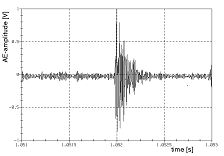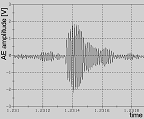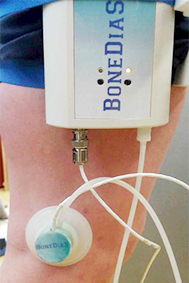Assessment of the Crack-Initiation-Threshold and changes in Bone Strength in the Human Femur under specific therapeutical bone training
The process of bone healing after a bone rupture or the changes in bone strength due to the osteoporotic disease afford the evaluation of the crack initiation thresholds in human bones for a successful and cost effective therapeutical regime. Mechanical loads applied during the diagnostic procedure for the assessment of the crack initiation threshold are not aimed at bone cracking. They are applied for the sole purpose to detect changes in the crack initiation thresholds due to the healing of a ruptured bone or the progress of the osteoporotic disease.
For the diagnostic assessment of the rupture probability of a human femur, limb motion and mechanical loading of the bone are essential. Limb motions and such bone loads are applied which are typical of the usual day to day load. Typical day to day loads of the human bone comprise rising from a chair, knee bows and walking up and down stairs. This typical bone loading is regarded as non destructive although micro cracks occur already in the compacta-spongiosa interface. The modern concepts of bone mechanics and bone turn over describe micro cracks as valuable parameters of bone strength and as necessary signals for the physiological remodelling of bone. Experience shows that bone strength is variable. For the evaluation of the changes in bone strength the assessment of the crack initiation threshold is the most valid parameter.
Following the results of fracture mechanics, the fracture toughness is based upon the analysis of acoustic emission produced by the initiation and propagation of cracks in materials. These processes can be monitored in vivo.

In Vivo monitoring of the Human Knee Joint
The acoustic emission analysis in addition to clinical aspects is a most valuable tool to monitor the initiation and the progress of cartilage lesions and arthritic damages of human joints. The centre of the joint monitoring is the analysis of the acoustic emission produced by the tribological processes in moving joints under the typical day to day load. The acoustic emission analysis allows the unambiguous detection of arthritic damages, of cartilage defects and of defects due to the changes in the angle of incident load. Here again, the typical day to day load comprises simple walking, rising from a chair, knee bows or riding on a bicycle ergometer.
The joint monitoring introduced in our system allows a detailed evaluation of joint defects. This is possible because our selective analysis of acoustic emission is performed in correlation to the state of flexion/ extension of the joint under consideration and to the reactive external load. The measuring system with the evaluation process introduced and applied by us is currently the only one world wide.

Clinical Benefit
This is a non invasive diagnosis of bone strength and joint damage exploiting the analysis of acoustic emission during a clinical evaluation, where well defined simple exercises are exerted typical for the daily practice of patients and probands.
Advantages over the established methods:
- Acoustic emission gives valid data on bone strength and joint damage.
- The whole process is painless.
- The whole process is non destructive.
- There is no health burden by irradiation, which is unavoidable in e.g. X-ray analysis.
- There is no danger of process-inherent infection because the process is non invasive.
- Very little time is needed ( a few minutes) for the complete assessment where a valid evaluation is included.
- The costs for the measurement system are very low compared to e.g. modern X-ray systems.
- The diagnostic costs per patient /proband are much lower in comparison to the established procedures and there are no subsequent costs through e.g. infections, which can happen after invasive procedures like endoscopic diagnostics.
- Ideally suited for the medical surveillance of the training of patients during rehabilitation or of sport professionals.

